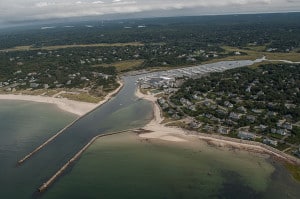
Rising nitrogen levels in Cape Cod waterways are targeted in a new plan by state and federal regulators to improve the peninsula’s wastewater treatment programs. Pictured is Sesuit Harbor in Dennis.
Developers on Cape Cod operate under challenging conditions: limited access to sewers and increasingly stringent environmental regulations that reflect heightened concerns about polluted water in the Bay State’s coastal vacationland.
The federal government’s first new wastewater plan for the Cape in nearly four decades could raise the hurdles even higher, while imposing clean-up costs that could top $5 billion on communities, according to environmentalists and regulators.
Approved Sept. 18, the Environmental Protection Agency’s Cape Cod water quality management plan gives the Cape’s 15 communities until June to submit plans to reduce pollution in 13 bays and estuaries stemming from septic systems, stormwater outfalls and sewage treatment plants.
“Now is the time they need to get real,” said Christopher Kilian, director of clean water for the Conservation Law Foundation (CLF). “They’re going to have to describe how to clean up the problem, from what pipes they put in where, to retrofits of the septic treatment plants, to financing.”
Even with updated cost estimates in the $2 billion to $3.8 billion range, the potential bill for Cape businesses and homeowners could be staggering, said Michael Leon, a real estate attorney with Boston-based law firm Nutter.
“The real question is how it’s going to affect development and property on the Cape, such as restaurant owners and hotels that have existing septic systems,” Leon said. “Do they have to upgrade their on-site systems, and what are going to be the costs of tying into sewers? No one has come to grips with the magnitude of the costs.”
The agreement also contains language that could take decision-making out of local hands, in a departure from longstanding Massachusetts tradition. It gives the state Department of Environmental Protection the ability to create new sewer districts if the goals aren’t met – including the power to borrow money, build treatment facilities and assess user fees on property owners, Leon said.
The new standards emerged after the CLF filed a series of lawsuits against the EPA beginning in 2010, claiming lax regulation of pollution sources on the Cape for decades.
In an era where cesspools were common, the EPA’s 1978 water quality plan concentrated on public health threats such as bacterial contamination of groundwater. But as development has boomed on the Cape in recent decades, environmentalists have focused on nitrogen that seeps into ponds and bays. The nutrients are blamed for algae blooms that foul waterways and threaten aquatic life.
The current plan is the outcome of settlement talks between regulators and the CLF, the same group that sued the now-defunct Metropolitan District Commission in 1983 and eventually forced the $4-billion cleanup of Boston Harbor.
Cape Cod Commission regulations already require developments to provide wastewater treatment ensuring no net increase in nitrogen. The EPA plan could require developers to reduce nitrogen levels, CLF’s Kilian said.
“Things only need to get tighter with regard to nitrogen,” he said.
On-site treatment systems are already required for many developments to meet permitting standards of local towns and the Cape Cod Commission.
A shared treatment system for a 120-unit residential development can bring up-front costs of over $1 million not including design and permitting, said Michael McGrath, president of Falmouth-based engineers Holmes & McGrath. The same system can cost $100,000 a year to operate and comply with testing and reporting requirements.
How much stricter the regulations become will be made clearer next summer when towns submit their comprehensive plans, which are subject to approval by the state Department of Environmental Protection.
Alternatives To Sewers
Some local officials on the Cape welcome the new agreement, saying it encourages communities to pursue innovative wastewater treatment strategies ranging from shellfish farms to underground pollution barriers, while minimizing big-ticket sewer expansions. The Cape Cod Commission estimated in 2013 that the Cape-wide clean-up costs could begin at $5.2 billion.
In Falmouth, a $37-million project hooking an additional 1,400 properties up to the town’s sewer system is underway. Consultants GHD have projected the town’s long-range wastewater upgrade costs at $100 million in coming decades.
But town officials are studying a variety of emerging technologies that they hope could treat wastewater with less disruption and cost.
In 2013, the town seeded 2 million oysters in its coastal Little Pond as part of a demonstration project designed to gauge the ability of shellfish to filter nitrogen. The results were positive and the program is being expanded to other areas, said Eric Turkington, chairman of the town’s water quality management committee.
Another experimental program will install permeable carbon-based underground barriers next spring between wastewater sources and waterways in East Falmouth, Turkington said. And in West Falmouth Harbor, 20 property owners have agreed to install advanced septic systems that provide nitrogen treatment.
The EPA ruling, Turkington said, opens the door to a wider variety of treatment options.
“The whole Cape has looked at this a different way the last few years,” Turkington said. “The idea was that sewering was your first choice and that alternatives like this were untested and unproven. It’s a very different attitude right now by the EPA and the state and the Cape Cod Commission.”
An EPA official agreed that the agreement encourages a “hybrid” approach that combines sewers with experimental treatment processes. Communities that share watersheds have natural incentives to work together on pollution plans, said Johanna Hunter, chief of watershed and non-point source programs for EPA New England.
Towns such as Falmouth that paid for comprehensive studies in recent years won’t be required to reinvent the wheel, Hunter said. But communities that don’t submit plans by the June deadline would risk access to state-sponsored loans and grants for water and sewer projects.
“It’s far better for Cape communities to be willing to invest now in protection and restoration of water quality, recognizing the Cape itself is a natural treasure,” Hunter said. “The amount of money you put forward now is to ensure your property values and commerce are not paying the price long-term.”




 |
| 



